This Content Is Only For Subscribers
THE INVASION BEGINS
In the summer of 1874, a specter began to loom over the Great Plains, from North Dakota all the way down to Texas. This was no ordinary threat, but a living, swarming, voracious one. It came in the form of billions of Rocky Mountain locusts, whose sheer numbers filled the sky, obscuring the sun for five incredible days. It was the locust swarm that blocked the sun for 5 days.
Post-Civil War settlers, having relocated to this vast expanse for a chance at a better life, were about to be confronted with an unprecedented calamity. The abundant rains of spring had held the promise of a bountiful harvest, only for the summer to be seized by drought – a condition not just unfortunate for the farmers but the perfect setup for the incoming horde of locusts.
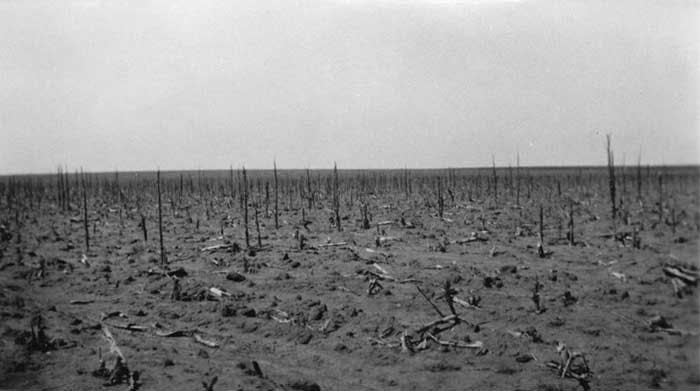
This locust swarm was part of a familiar life cycle. Normally, at low population densities, these insects behave like their close relatives, the grasshoppers. However, when crowded, a chemical transformation begins, triggered by cues from their feces and disturbance of tiny hairs on their hind legs. It’s an astonishing metamorphosis turning an ordinary insect into a voracious mob.
A LOCUST STORM DESCENDS
The Rocky Mountain locust, naturally native to drier habitats, found the arid conditions conducive and took flight in search of sustenance. These insects, typically about an inch and a half in length, descended upon the prairies in late July. They had journeyed from the mountains of Colorado, Wyoming, and Montana, and they seemed unending.
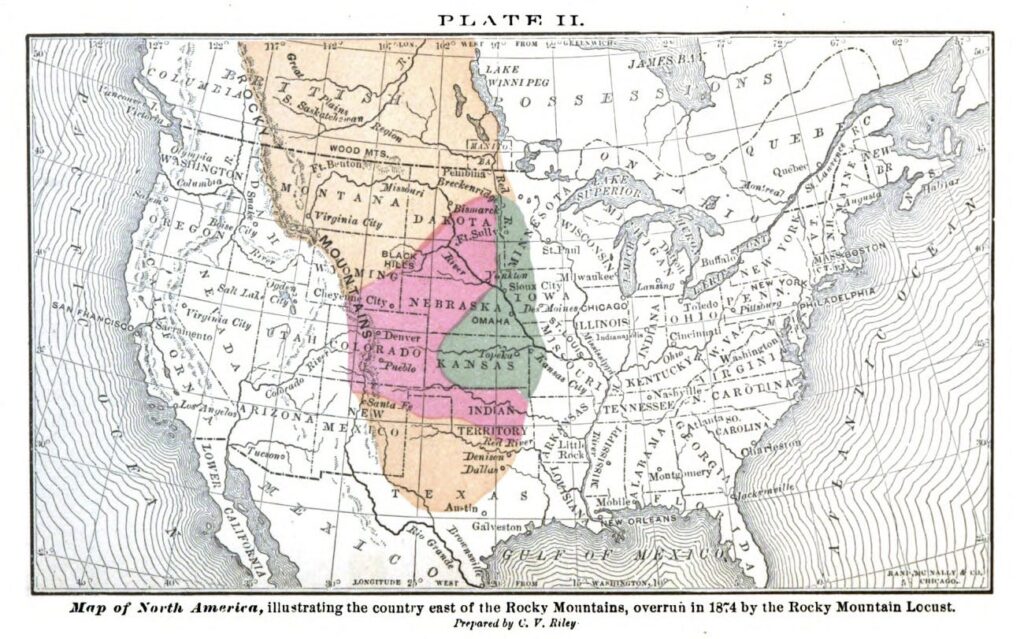
The locusts, as reported by an awestruck farmer, looked “like a great white cloud, like a snowstorm, blocking out the sun like vapor.” Their arrival was sudden and overwhelming. Farmers rushed to shield their crops and wells, a futile gesture against the unyielding locusts who munched through even fabric coverings.
It was the largest congregation of animal life ever recorded by humans; a super-organism composed of an estimated 120 billion to 12.5 Trillion individuals. A metabolic wildfire racing across the Great Plains, decimating a vast region of pioneer agriculture and leaving devastation in its wake.
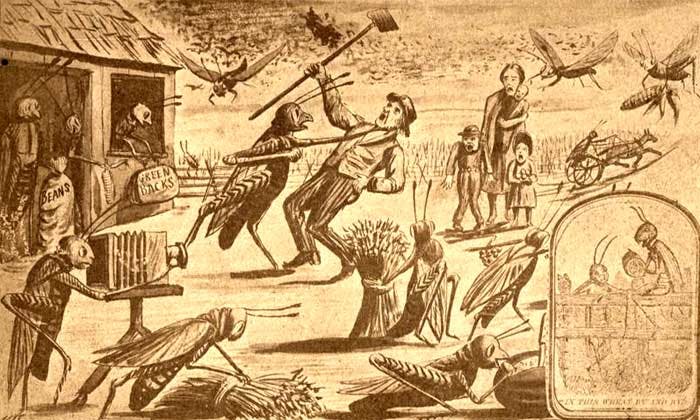
THE LOCUST SWARM THAT BLOCKED THE SUN
Imagine a swarm so enormous, it covered an estimated area of 198,000 square miles – nearly the combined size of the states of Wyoming and Colorado. In the “Second Report of the United States Entomological Commission,” Dr. A.L. Child of the U.S. Signal Corps calculated these staggering figures by clocking the insects’ speed and telegraphing surrounding towns. The locusts streamed overhead, a suffocating mass of insects blotting out the sky for an unbelievable five days.
What followed was a scene straight out of a horror movie, perhaps directed by Hitchcock himself. Their bodies darkened, their wings grew longer, and they became a rapacious swarm. With a striking resemblance to the “Mongol hordes,” the cloud of Rocky Mountain locusts descended upon the landscape.
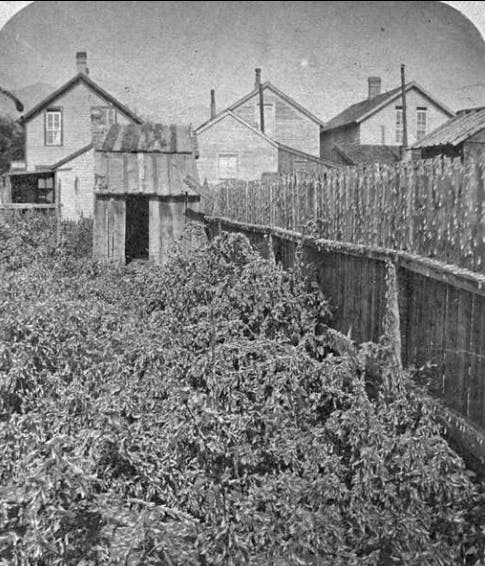
Laura Ingalls Wilder in her book “On the Banks of Plum Creek” depicted the surreal scene vividly. She recounted how the locusts, appearing like a dark cloud, began to rain down on the land. They covered every surface, clinging to the skin and clothes, their rasping wings filling the air with an eerie whirring sound. Their mass was so immense that the ground itself was concealed beneath a writhing layer of insects.
NO GREEN THING SAFE
The locusts did not discriminate. After decimating the crops, they moved on to consuming wool straight from the sheep. Then they went after the clothing off people’s backs, paper, tree bark, sawdust, leather, and even wooden tool handles. They left in their wake, a landscape stripped bare, as if ravaged by fire.
Those affected the most were the newcomers, the emigrants of western Kansas. As the insects covered the ground several inches deep, the steel tracks of the locomotives became too slick with their crushed bodies for trains to gain traction. One correspondent from the New York Times commented on the onslaught, noting that the locusts “beat against the houses, swarm in at the windows, cover the passing trains… They work as if sent to destroy.”
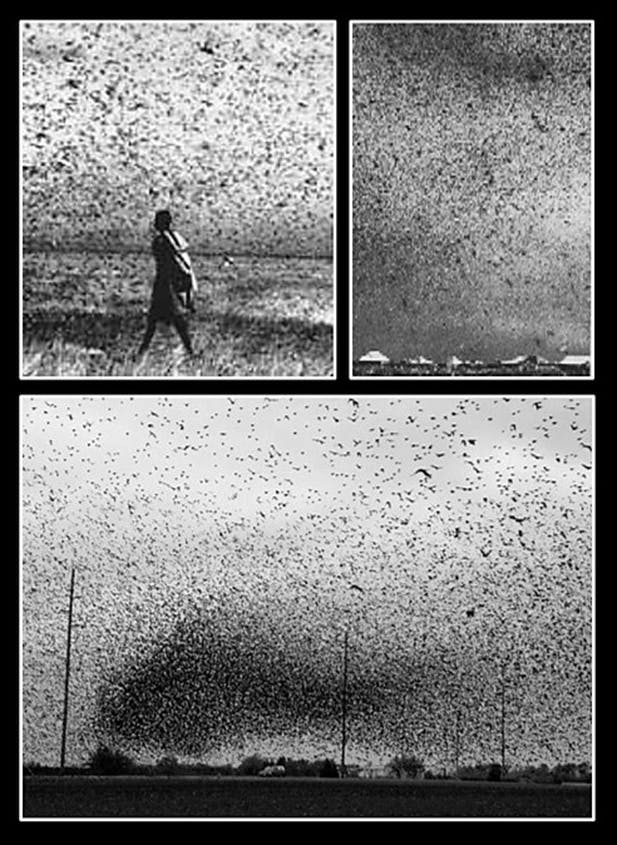
A STRUGGLE FOR SURVIVAL
Amid the devastation, a grim reality took hold. Many couldn’t survive, succumbing to starvation. As described heartbreakingly by a St. Louis Republican report that seemed to promise more graves marked “STARVED TO DEATH.” To prevent such a dire situation, Governor Thomas A. Osborn called a special legislative session in September 1874. In response, the legislature approved $73,000 in bonds to aid the ravaged districts.
Such was the extent of the devastation that U.S. troops had to be mobilized to distribute food, blankets, and clothing to devastated farm families. The Rocky Mountain locusts had feasted on vegetation leaving the pioneers helpless in the face of their destructive appetite.
A plea for help echoed across America. The country responded, with supplies of beans, pork, rice, and seed transported free of charge by the railroads to the farmers in Kansas. The total assistance amounted to $235,108.47, along with clothing for more than 34,000 individuals.
THE END OF THE LOCUST PLAGUE
For three long years, the locusts held sway. Their devastation totaled $200 million in crop damage across several states, covering an area equivalent to California. Then, just as suddenly as it had begun, the Rocky Mountain locust began to mysteriously disappear in the late 1880s.
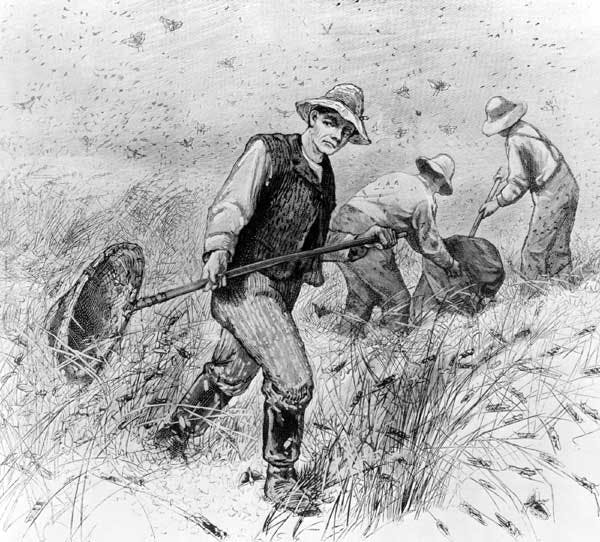
One prevailing theory credits the settlers’ agricultural practices for the locusts’ eventual demise. The incessant plowing, irrigation, and trampling by cattle near rivers and streams in the Rocky Mountains might have destroyed their eggs in the areas they permanently inhabited. As a result, the once great swarm that blocked the sun for five days vanished from the earth. The last sighting of a Rocky Mountain locust was in 1902.
This tale serves as a vivid reminder of the resilience of the human spirit and our ability to adapt and survive in the face of even the most daunting of natural adversities. As we go about our lives in the quietude of the Great Plains today, let us remember the settlers of the past who stood their ground against the sky-darkening swarm of yesteryear.

 Additional Facts
Additional Facts
$12.2 Trillion
Some estimates put the number of locusts in the swarm to 12.4 Trillion. On the lower end the estimates are around 120 Billion. Either way, it was the largest recorded gathering of an animal species on Earth.
27.5 Million Tons
Approximate weight of the biomass of the swarm.
$100 reward
was offered to bounty hunters for a Bushel of dead locusts. A Bushel is a little more than 9 liquid gallons.



